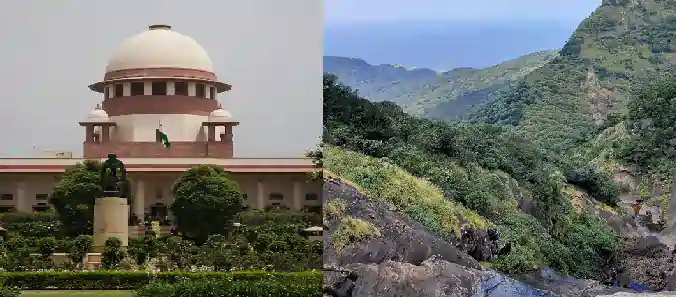New Delhi: In a decisive move to protect one of India’s ecological crown jewels, the Supreme Court has ordered an urgent and detailed investigation into the Agasthyamalai landscape, a biodiversity-rich region straddling Tamil Nadu and Kerala. Issued on April 5, 2025, this ruling targets rampant encroachments and illegal activities threatening the area’s forests and wildlife. With the Central Empowered Committee (CEC) tasked to deliver a comprehensive report within 12 weeks, this case could redefine India’s approach to conservation. Here’s an in-depth look at the ruling, its origins, and what’s at stake.

Agasthyamalai: A Vital Ecosystem in Peril
Tucked into the southern reaches of the Western Ghats, the Agasthyamalai landscape spans roughly 3,500 square kilometers across two states. It’s a globally recognized treasure, listed under UNESCO’s Man and Biosphere Program as a biosphere reserve. Home to sprawling sanctuaries like the Periyar Tiger Reserve, Srivilliputhur Grizzled Squirrel Wildlife Sanctuary, and Meghamalai Wildlife Sanctuary in Tamil Nadu, plus Shendurney, Peppara, and Neyyar in Kerala, it also encompasses the Kalakkad Mundanthurai Tiger Reserve—a linchpin for tiger survival.
This region teems with life: over 2,200 plant species, including unique finds like the ‘Arogyapacha,’ a medicinal marvel dubbed the ‘Plant of Eternal Health,’ and the breathtaking ‘Neelakkurinji,’ which paints the hills blue every dozen years. Its animal residents include rare gems like the Bengal tiger, Nilgiri tahr, and sloth bear. Fourteen rivers, such as the Thamirabarani, spring from its slopes, nourishing ecosystems and communities alike. Yet, beneath this natural splendor lies a growing crisis: human encroachment gnawing at its core.
A Historical Wound: The Singampatti Legacy
The trouble began nearly a century ago, in 1929, when the Zamindar of Singampatti handed over 3,388.78 hectares of lush forest to the Bombay Burma Trading Corporation Limited (BBTCL) under a 99-year lease. The goal? To carve out tea and coffee plantations. For decades, these estates thrived, supporting a workforce of thousands. But over time, the land’s status evolved. By 1978, it was classified as part of the Kalakkad-Mundanthurai Reserved Forest. Later designations as a Core Critical Tiger Habitat (2007), Wildlife Sanctuary, and Tiger Reserve (2012) shifted priorities from commerce to conservation.
This transformation wasn’t smooth. Authorities moved to reclaim the land, evicting tea estate workers who had called it home for generations. These workers fought back, filing petitions for rehabilitation and compensation. The Madras High Court stepped in, ordering support for the displaced, but left a glaring gap: the fate of the ravaged forest itself. That gap has now drawn the Supreme Court’s attention.
The Court’s Command: Science Meets Justice
On April 5, 2025, Justices Vikram Nath and Sandeep Mehta issued a powerful directive in the case of A. John Kennedy v. State of Tamil Nadu & Others. They painted a vivid picture: forests as the “lifeblood of our planet,” essential for staving off climate collapse and preserving biodiversity. Echoing past rulings, they stressed that tigers and forests are inseparable—lose one, and the other crumbles.
The Court turned to the CEC, a judicially created watchdog from 2002, to spearhead the response. Its mission is threefold:
- Expose Lawbreakers: Track down activities flouting the Forest Conservation Act, 1980, and Wildlife (Protection) Act, 1972.
- Map the Damage: Deploy high-tech tools—think satellite imagery and geo-mapping—to reveal the extent of forest loss.
- Plan a Comeback: Suggest concrete steps to heal reserved forests, tiger zones, elephant paths, and sanctuaries.
The CEC’s scope covers the Periyar Tiger Reserve, Srivilliputhur, Meghamalai, and Tirunelveli sanctuaries, with state officials ordered to lend a hand. The deadline? Twelve weeks, setting the stage for a crucial follow-up hearing on July 15, 2025.
India’s Forests: A Fragile Frontier
This case unfolds against a sobering national backdrop. India’s forest cover, per the 2023 India State of Forest Report, stands at 715,343 square kilometers—barely 21.76% of its territory. Compare that to Bhutan’s lush 72% or Nepal’s 44.74%, and the gap is stark. Worse still, the Environment Ministry recently told the National Green Tribunal that 13,000 square kilometers of forest land are illegally occupied. Urban sprawl, industrial greed, and unchecked settlers are to blame, chipping away at nature’s defenses.
India’s legal framework fights back. The Forest Conservation Act demands central approval for non-forest uses, while reserved forests—like those in Agasthyamalai—are locked down tight, barring all but permitted activities. The Wildlife (Protection) Act shields critical habitats, balancing tribal rights with conservation. But laws alone aren’t enough when enforcement falters, a reality the Supreme Court aims to change.
Nature First: A New Mindset
The justices leaned on a fresh legal lens: an “ecocentric” view, where nature trumps human convenience. Drawing from a 2024 ruling (State of Telangana v. Mohd. Abdul Qasim), they argued that ecosystems deserve precedence. Senior Advocate K. Parameshwar, tapped as Amicus Curiae, bolstered this with a plea for precision. He urged the use of science—satellites, sensors, maps—to pinpoint forest boundaries and halt further loss. The Court agreed, embedding this rigor into its order.
What’s Next: Hope and Hurdles
If the CEC delivers, the Agasthyamalai landscape could see a renaissance. Restored forests might roar with tigers again, elephant trails could reopen, and rivers might flow stronger. For the tea workers, a fair rehabilitation plan could ease their transition, ideally without new forest scars. Beyond Tamil Nadu, this case could spark a nationwide push to reclaim lost greenery.
But it’s not a done deal. Coordinating science, policy, and people is tricky. The state must follow through, and the CEC’s findings must hold weight in July’s hearing. Success hinges on willpower—both judicial and governmental.
A Global Echo
This isn’t just India’s story. Forests worldwide are shrinking, fueling 11% of global emissions, per UN data. With climate deadlines like the 2030 biodiversity targets looming, Agasthyamalai’s fight mirrors a planetary one. As a UNESCO site, its revival could inspire others, proving conservation can win against the odds.
FAQs
1. What prompted the Supreme Court to order an investigation into the Agasthyamalai landscape?
The Supreme Court acted due to long-standing encroachments in Tamil Nadu’s Agasthyamalai region, particularly the Singampatti Zamin forests, which were leased in 1929 for tea and coffee plantations. Over decades, these lands were reclassified as reserved forests and tiger habitats, leading to worker evictions and ecological damage. On April 5, 2025, the Court intervened to address violations of forest and wildlife laws, prioritizing restoration.
2. What is the Central Empowered Committee (CEC) tasked with in this case?
The CEC must conduct a 12-week survey of the Agasthyamalai landscape, covering areas like the Periyar Tiger Reserve and Meghamalai Wildlife Sanctuary. Its job includes identifying illegal non-forestry activities, mapping encroachments with tools like satellite imagery, and recommending steps to restore forests, tiger habitats, and elephant corridors, all due by July 15, 2025.
3. Why is the Agasthyamalai landscape so important?
Spanning Tamil Nadu and Kerala, Agasthyamalai is a UNESCO-recognized biosphere reserve in the Western Ghats. It’s home to over 2,200 plant species, rare animals like the Bengal tiger, and 14 rivers, including the Thamirabarani. Its ecological role—supporting biodiversity and water systems—makes it critical, yet encroachments threaten its survival.
4. How does this ruling connect to India’s broader forest crisis?
India’s forest cover is just 21.76% of its land, with 13,000 square kilometers encroached, per recent reports. The Supreme Court’s focus on Agasthyamalai reflects a national push to reverse this trend, using laws like the Forest Conservation Act, 1980, to protect vital ecosystems amid climate change pressures.
5. What happens next after the CEC’s survey?
The CEC will submit its findings by mid-July 2025, and the Supreme Court will review them on July 15, 2025. Depending on the report, the Court could order specific restoration actions, rehabilitation for displaced workers, or stricter enforcement, potentially influencing conservation policies across India.

